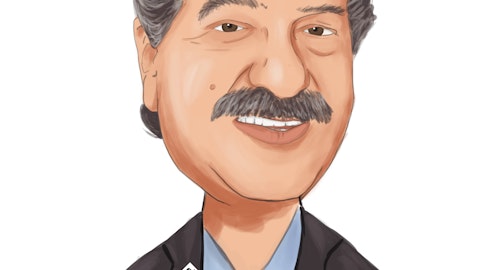Wintrust Financial Corporation (NASDAQ:WTFC) Q3 2023 Earnings Call Transcript October 18, 2023
Operator: Welcome to Wintrust Financial Corporation’s Third Quarter and Year-to-Date 2023 Earnings Conference Call. A review of the results will be made by Tim Crane, President and Chief Executive Officer; David Dykstra, Vice Chairman and Chief Operating Officer; and Richard Murphy, Vice Chairman and Chief Lending Officer. As part of their reviews, the presenters may make reference to both the earnings press release and the earnings release presentation. Following their presentations, there will be a formal question-and-answer session. During the course of today’s call, Wintrust management may make statements that constitute projections, expectations, beliefs or similar forward-looking statements. Actual results could differ materially from the results anticipated or projected in any such forward-looking statements.
The company’s forward-looking assumptions that could cause the actual results to differ materially from the information discussed during this call are detailed in our earnings press release and in the company’s most recent Form 10-K and any subsequent filings with the SEC. Also, our remarks may reference certain non-GAAP financial measures. Our earnings press release and earnings release presentation include a reconciliation of each non-GAAP financial measure to the nearest comparable GAAP financial measure. As a reminder, this conference call is being recorded. I will now turn the conference over to Mr. Tim Crane.

A successful business person confidently managing their finances on a mobile device. Editorial photo for a financial news article. 8k. –ar 16:9
Tim Crane: Good morning, everybody. Welcome to Wintrust Wednesday. This is the day of the week we require all of our Wintrust staff to be on site. We’re glad that you have joined us too for our third quarter earnings call. With me this morning are Dave Dykstra, our Chief Operating Officer; Rich Murphy, our Chief Lending Officer; Dave Stoehr, our Chief Financial Officer; and Kate Boege, our General Counsel. In terms of an agenda, I will share some high-level highlights. Dave Dykstra will speak to the financial results, and Rich will add some additional information and color on credit performance. I’ll wrap up with just a few summary thoughts. And as always, we’ll do our best to answer some questions. Earnings or net income for the quarter were just over $164 million, up from both the second quarter and the paired quarter last year.
From our standpoint, a very solid result with good loan and deposit growth and continued good credit performance. As Rich will highlight, we are not seeing any systemic credit issues at this point. Our margin at 3.62% was within the range we expected, down essentially just for the impact of our hedging activities. We continue to benefit from a loan portfolio that prices relatively quickly. You’ll recall that nearly 80% of our loans mature or reprice within a year. The resulting improvement in loan yield allows us to largely offset the increase in deposit costs, which I would add, we believe, are moderating at this point. Our growth in the relatively stable margin resulted in net interest income growth for the quarter and on a year-over-year basis.
From a market standpoint, we continue to see isolated disruption among competitors. And as a result, we continue to add clients and create long-term franchise value. We expect that in the coming quarters, we will continue to grow loans and deposits. Our liquidity position remains strong. The deposit growth not only allowed us to fund good loan growth, but also to reduce the level of brokered deposits during the quarter. Again, overall, a solid quarter, which we believe will compare well and, in fact, may differentiate us relative to many of our competitors. With that, I’ll turn this over to Dave to provide some additional financial details.
David Dykstra: Great. Thanks, Tim. First, with respect to the balance sheet growth, we were again pleased to see deposits for the quarter grew by approximately $1 billion or 9% on an annualized basis. This deposit growth was primarily in the form of interest-bearing retail deposits, and that growth allowed us to reduce our level of broker deposits by $392 million. As to deposit composition, non-interest-bearing deposits at the end of the quarter represented 23% of total deposits compared to 24% at the end of the second quarter. The slight reduction in the percentage of non-interest-bearing deposits to total deposits is really more a reflection of the positive growth occurring in the interest-bearing categories, rather than any large losses of non-interest-bearing deposit accounts.
We’ve seen the non-interest-bearing balances stabilize as evidenced by the $10.6 billion of average non-interest-bearing deposit balances in the third quarter, being roughly equal to the $10.6 billion balance at the end of the second quarter. This strong deposit growth helped to fund solid loan growth of $423 million during the third quarter. Adjusting for the impact of the sale of certain commercial insurance premium finance loans during the third quarter, total loans increased $767 million or 7% on an annualized basis, which is consistent with our prior guidance of mid to high single-digit loan growth. The increase in loans was primarily the result of draws on existing commercial real estate loan facilities as well as growth in the commercial portfolio.
Additionally, despite the loan sale transaction that reduced outstanding balances by $344 million at the end of the third quarter, the commercial insurance premium portfolio ended relatively unchanged, which is a good result. Rich Murphy will discuss the loan portfolio growth in more detail in just a bit. The result of these and other balance sheet movements was growth in total assets of approximately $1.3 billion, the slightly reduced ending loan-to-deposit ratio of 92.1% and risk-based capital ratios that were relatively stable to up a little. Overall, it was a very successful quarter in the growth of our franchise, our differentiated business model, exceptional service, and the unique positioning that we have in Chicago and Milwaukee markets continues to serve us well.
Turning to the income statement categories, starting with the net interest income. For the third quarter of 2023, net interest income totaled $462.4 million, an increase of approximately $14.8 million as compared to the prior quarter, and an increase of $60.9 million as compared to the third quarter of 2022. I should note that the third quarter net interest income represents the highest quarterly amount ever recorded by the company. The increase in net interest income as compared to the prior quarter was primarily due to the increase in average earning assets of approximately $1.6 billion. The net interest margin was 3.62% in the third quarter, which was just 4 basis points less than the prior quarter level of 3.66%. Three of the four basis points of the decline was due to the impact of our interest rate hedging strategies, which are designed to protect our net interest income if interest rates decline.
Accordingly, as we discussed on prior calls, our balance sheet composition, structure and repricing characteristics provided for a relatively stable net interest margin during the quarter. Deposit pricing moderated in the third quarter of 2023, and we expect that to continue into the fourth quarter. Based on the current interest rate environment, we believe we can maintain our net interest margin within a narrow range around the current levels for the remainder of 2023. And I’d also like to note that total loans as of September 30, 2023, were $739 million higher than the average total loans in the third quarter of 2023. This provides momentum into the fourth quarter. This growth in the — expected growth in the balance sheet and the relatively stable net interest margin should allow for future growth of our net interest income in the fourth quarter.
Turning to the provision for credit losses. Wintrust recorded a provision for credit losses of $19.9 million in the third quarter compared to a provision of $28.5 million in the prior quarter and $6.4 million provision expense recorded in the year-ago quarter. The lower provision expense in the third quarter relative to the second quarter was primarily a result of lower net loan growth during the third quarter. Rich Murphy will talk about the credit and loan characteristics in just a bit. Regarding non-interest income and non-interest expense sections. Total non-interest income totaled $112.5 million in the third quarter, and was relatively stable when compared to the prior quarter total of $113.0 million. As shown in the table in our earnings release, there are a number of relatively small changes to a variety of non-interest income categories.
But in the aggregate, the changes netted to a slight decrease of $552,000 from the prior quarter. This illustrates the importance of having a diversified fee businesses that can contribute at various levels over time and the ability of those business lines to maintain a relatively stable level of non-interest income, despite what is a challenging mortgage environment. On the non-interest expense categories. Non-interest expenses totaled $330 million in the third quarter of 2023, and were up approximately $9.4 million when compared to the prior quarter total of $320.6 million. Now, there are a few primary reasons for the increases which are related to the negative impacts of, one, occupancy cost of approximately $2.9 million from the impairment of two company-owned buildings that are no longer being used.
Two, data processing costs of approximately $1.5 million from a termination of a duplicate service contract related to the acquisition of the wealth management business in 2023. Other salary costs of approximately $1.6 million related to acquisition severance charges — acquisition-related severance charges and other contractually due compensation costs. And then we also had an increase in our commissions and incentive compensation of $4.3 million, primarily because of the adjustments to our incentive compensation accruals due to the strong earning levels. The remainder of the variances in the non-interest expense categories, both positive and negative, generally offset to a relatively small remaining change. So despite the growth in the non-interest expenses and the uncommon nature of some of the items that I just noted, the company’s annualized ratio of non-interest expenses as a percent of average quarterly assets actually declined by 3 basis points to 2.41% in the third quarter.
Additionally, our efficiency ratio remained stable at 56.9% in both the second and the third quarters of 2023. And similarly, the company’s net overhead ratio was relatively stable at 1.59% in the third quarter, and increased just 1 basis point from the 1.58% recorded in the prior quarter. So in summary, this was a very solid quarter with strong loan and deposit growth, improved liquidity position, stabilized net interest margin with a steady outlook, a record level of net revenues, continued low levels of non-performing assets and the second highest quarterly net income result in the company’s history. We feel like we’ve managed well through a somewhat turbulent period thus far in 2023, delivering net income that was a record for the first nine-month period of any fiscal year in the history of the company, and we have a positive outlook for continued growth in assets, revenues and earnings.
So with that, I will conclude my comments and turn it over to Rich Murphy to discuss credit.
Richard Murphy: Thanks, Dave. As noted earlier, credit performance continued to be very solid in the third quarter from a number of perspectives. As Dave noted and as detailed on Slide 6 of the deck, loan growth for the quarter was $423 million. If you adjust for the sale of the premium finance loans in July, total loans increased by $767 million or 7% on an annualized basis. This growth is due to a number of factors. Commercial premium finance volumes remain strong as we continue to see a significantly harder market for insurance premiums, particularly for commercial properties, resulting in higher average loan sizes. We also continue to see new opportunities as a result of consolidations within the premium finance industry.
Finally, we saw good growth in commercial real estate, largely from draws on existing construction loans, and our leasing group had another solid quarter. This rate of loan growth when adjusted for the sale of loans in the quarter, is in line with our guidance of mid to high single digits. We also believe that loan growth for the fourth quarter will continue to be within our guidance for the following reasons. Commercial premium finance should continue to show solid growth. Our core C&I pipelines look very good, and our leasing teams continue to see significant demand in the market. And as we have noted on prior calls, we continue to benefit from disruptions in the banking landscape, and have seen numerous quality opportunities in our core businesses.
In addition, we are looking at a number of lending teams and niche lending opportunities that come from dislocations at other regional banks. Offsetting this growth will be continued pressure on line utilization, which is down to 37% as higher borrowing costs have negatively affected usage for the past several quarters, and we anticipate that higher borrowing costs will continue to cause borrowers to reconsider the economics of new projects, business expansion and equipment purchases. In summary, we continue to be optimistic about loan growth for the balance of 2023, and we believe our diversified portfolio and position within the competitive landscape will allow us to grow within our guidance of mid to high single digits and maintain our credit discipline.
From a credit quality perspective, as detailed on Slide 13, we continue to see strong credit performance across the portfolio. This can be seen in a number of metrics. Non-performing loans increased by $24 million in the quarter, from 26 basis points to 32 basis points. However, $20 million of this increase is in the premium finance portfolio. These loans are secured by the unearned premiums, and we would anticipate no additional losses. Overall, NPLs continue to be at historically low levels, and we are confident about solid credit performance of the portfolio going forward. Charge-offs for the quarter were $8.1 million or 8 basis points, down from $17 million in the second quarter. And finally, as detailed on Slide 13, we saw stable levels in our special mention and substandard loans, with no meaningful signs of additional economic stress at the customer level.
As noted in our last few earnings calls, we continue to be highly focused on our exposure to commercial real estate loans, which composed roughly one-quarter of our total portfolio. Higher borrowing costs and pressure on occupancy and lease rates are cause for concern, particularly in the office category. On Slide 17, we’ve updated a number of the important characteristics in our office portfolio. Currently, this portfolio remains steady at $1.4 billion or 13% of our total CRE exposure and only 3.4% of our total loan portfolio. Of the $1.4 billion of office exposure, 42% is medical office or owner occupied. The average size of a loan in the office portfolio continues to be around $1.3 million, and we have only five loans above $20 million. We continue to closely monitor loans secured by office properties located within central business districts.
Our CBD exposure is limited to $364 million or approximately one-quarter of the office portfolio. Half of this is in Chicago and half of this is in other cities. The bulk of our portfolio is located in suburban areas and areas outside central business districts. And NPLs in this category were flat quarter-over-quarter and continue to be at very nominal levels. We continue to perform portfolio reviews regularly on this portfolio, and we stay very engaged with our borrowers. As we have noted previously, we are not immune for the macro effects that challenge this product type, but we believe our portfolio is well constructed, very granular and should perform well moving forward. To better understand the stresses in our portfolio, our CRE team updated their deep dive analysis on every loan over $2.5 million, which will be renewing between now and the second quarter of 2024.
This analysis, which covered 80% of all CRE loans maturing during this period resulted in the following. Roughly one-half of these loans will clearly qualify for a renewal at prevailing rates. Roughly 35% of these loans are anticipated to be paid off or will require a short-term extension at prevailing rates. The remaining 16% of these loans will require some additional attention, which could include a paydown or a pledge of additional collateral. We have back-checked the results of these deep dives conducted during prior quarters, and have found that the projected outcomes versus actual outcomes were very tightly correlated. And generally speaking, borrowers whose loans deemed to require additional attention, continue to support their loans by providing enhancements, including principal reductions.
Again, our portfolio is not immune from the rising effects — from the effects of rising rates or the market forces behind lease rates, but we have been diligently identifying weaknesses in the portfolio and working with our borrowers to identify the best possible outcomes, and we believe that our portfolio is in reasonably good shape and situated to weather the challenges ahead. That concludes my comments on credit, and I’ll turn it back to Tim.
Tim Crane: Thanks, Rich. Just to wrap up our prepared remarks, we continue to believe that we’re very well positioned, perhaps uniquely positioned to take advantage of the current environment with our diverse businesses. Although the last several quarters, we’ve taken steps to achieve an interest rate sensitivity position much closer to neutral, we will benefit from rates that may be higher for longer. And based on current economic conditions and current banking conditions, we expect a margin that will be reasonably stable in a narrow range around the current level for the coming quarters. Rich noted some evidence of slowing economic activity. I can tell you we remain very active but disciplined in what I would call a choppy market. But as also noted, there are clearly opportunities, and we will continue to pursue them aggressively in the coming months. At this point, I’ll pause and Latif, if you open it up, we can take some questions.
See also 20 Best Value Investing YouTube Channels and 15 States with No Income Tax or Sales Tax.
Q&A Session
Follow Wintrust Financial Corp (NASDAQ:WTFC)
Follow Wintrust Financial Corp (NASDAQ:WTFC)
Operator: [Operator Instructions] Our first question comes from the line of Jon Arfstrom of RBC Capital Markets.
Tim Crane: Good morning, Jon.
Jon Arfstrom: Yeah, good morning, guys. Tim, a question for you on topic you just discussed on the kind of the near-term versus medium-term margin outlook. Are you saying that beyond the fourth quarter, based on the asset pricing cadence that you see, that the margin can start to march higher in 2024? Is that stable in the fourth quarter, potentially moving higher in ’24? Is that the message?
Tim Crane: Yeah. I mean I think there’s obviously a number of moving pieces to this, Jon. At the moment, looking out a quarter or two, we think, pretty stable. After that, I think there’s signs that we would feel optimistic about. But clearly, there’s a lot that goes into it past the next quarter or two.
Jon Arfstrom: Okay. How about hedging appetite? Is the plan to continue to hedge more? Do you feel like you’ve done what you need to do?
Tim Crane: Well, one, for those of you that are kind of following, there is a description of our hedges in the appendix that we share with everybody. That shows about $6.3 billion of hedges, one added in the first — or in the third quarter. We’ve subsequently added another small hedge. And I think we would continue to kind of follow the market up, Jon, if we have the opportunity to do that. As we’ve talked about, our desire is to certainly narrow the downside exposure on our margin. And we performed well with the margin in the mid-3s. We work hard to stay in that range.
Jon Arfstrom: Okay. Thank you for that. And then, Rich, a question for you on the premium finance non-performers. Can you — I think I understand it, but can you explain it and why is it up? And when does this stuff get resolved naturally?
Richard Murphy: Yeah. Well, two different buckets of loans there, Jon. So — and roughly equal to each other. If you look at Page 13, there is Slide 13. You can kind of see what the effects are. So I’ll take each one individually. In the P&C side, we are seeing a little bit more stress in the transportation area. So those loans are falling more delinquent more often. We do the analysis on those, and if there is a loss, we will take the loss, and then we’ll get the unearned premium back from the carrier. So it’s — in that situation, there is some economic deterioration that is causing more of those numbers to go 90 days past due. Now that’s — again, the loss given default is unchanged there, but you are seeing incidents of default go up there in that category.
The life category is a little bit different, and it’s a similar amount, about $10 million. And those really result from, as rates have come up and people get to the maturity of their loan, and they are looking at renewing that policy, they have to make a decision whether it still makes economic sense for them. And those conversations can get elongated, and we are — want to work with our clients and give them time to make that decision in a orderly fashion. So we are not necessarily automatically sending — canceling the policy and going back to the carrier. We want to make sure that we work with the client. So those might extend beyond 90 days past due. But generally speaking, they’re always going to be fully insured, and we wouldn’t anticipate that there would be any problems there.
Those loans that are 90 days past due that we have identified here, we would anticipate that those will be gone by the end of this month.
Jon Arfstrom: Okay. Okay. And on the commercial NPLs, if this is a persistent issue, you’re saying that you’re thinking that could remain elevated, but this is kind of the nine-month loan on a 12-month insurance contract. Is that that’s the structure? Is that right?
Richard Murphy: Yeah. That’s right. But the — and we do think that loans within our P&C portfolio that apply to transportation will have a little bit more pressure, and you still may see ongoing defaults. A couple of important points there is that we are getting a pretty good-sized premium on those, and we get reasonable late charges. So we are getting paid for that risk. So we’re not all that concerned about it from that perspective. But we also are taking some measures here to make sure that we are — our underwriting is maybe addressing some of those things. So we are getting a little bit tighter in that space. But generally speaking, again, while this is an elevated level, we’re not concerned about future losses out of it.
Jon Arfstrom: Okay. All right. Thank you very much.
Operator: Thank you. Stand by for our next question. Our next question comes from the line of Chris McGratty of KBW.
Tim Crane: Hi, Chris.
Chris McGratty: Hey, good morning. Dave, I want to just go at the NII. Again, the — a lot of your peers are still defending the trough or trying to find the trough for six months out. You gave the guide for continued growth in NII in Q4, kind of a stable-ish margin in higher for longer. You’ve got that unique back book. But it would feel like NII continues to grow throughout 2024. Maybe the pace is not as significant. But is that a fair estimate based on what you see in the world?
David Dykstra: Well, yeah, I think that’s how we look at it, Chris. Obviously, the Fed kills the economy and loan growth slows quite a bit, that would have an impact. But the benefit of being diversified in our asset classes, as Rich has said many times in the past, is if one area slows down and other area is doing okay. So we do think we can keep growing our loans in that mid to high single-digit range. Again, as Tim just talked about on the prior question, we think stable and potentially optimistic in the latter half of the year as far as the margin goes. But again, it depends on where the interest rate curve is and all that kind of stuff and how competitive deposit cost is. If that picks up right now, we said we see it moderating. So it’s very positive. So I guess a long-winded answer to say, yeah, we still think we can grow mid to high single digits, and we think the margin is stable. So if that’s the case, we think we can have growth.
Chris McGratty: Okay. Great. Just on the loan sales, can you just remind us — you talked about it last quarter, kind of testing the plumbing. I mean, should we expect more of that to occur? And was there a — I assume there’s a gain that showed up in the non-interest income. Just trying to get to logistics.
David Dykstra: Yeah. Well, we’re not planning on any right now. As you said, I mean, we — if you go back into the second quarter when we started to plan this and we did the sale early in the third quarter as we talked about on the last call. We really did it as a way to demonstrate that, that portfolio has liquidity. And it pays down very rapidly. We would expect the majority of that impact to be gone by the end of this fiscal year, since these are nine-month full payout loans, and we’ll be six months into it. So there’ll be very little, really left of that impact. But we wanted to be able to demonstrate that we had liquidity. We wanted to be able to have — make sure we had a tool in case concentrations of those premium finance portfolios got too high.





